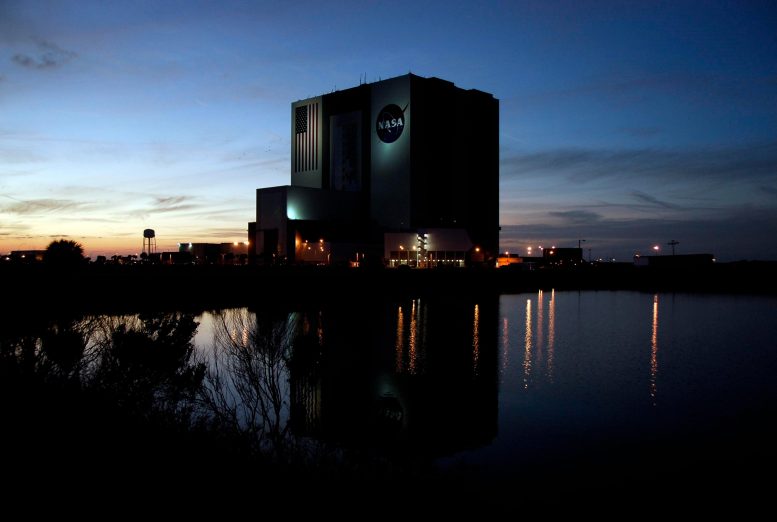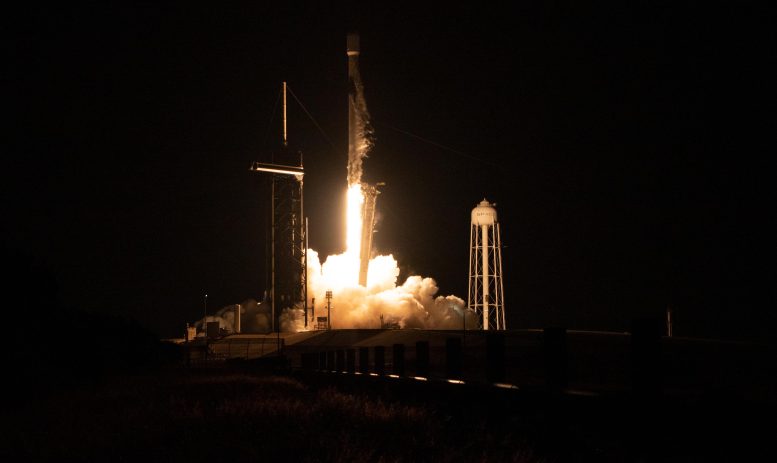
The dark water of the turn basin at NASA’s Kennedy Space Center mirrors the night lights and the Vehicle Assembly Building and Launch Control Center, silhouetted against the post-sunset sky. Credit: NASA/Kim Shiflett
NASA’s PACE satellite launch is timed for early morning to achieve a Sun-synchronous orbit, ensuring consistent sunlight for accurate Earth monitoring. Precise calculations ensure optimal positioning for ocean data collection, with a tight launch window highlighting the mission’s precision.
There’s a good reason why NASA’s PACE satellite is launching in the early morning hours. Late tonight, I’ll venture out in the chilly Merritt Island air to catch a glimpse of a historic sight. At 1:33 a.m. EST , February 6, (now delayed to 1:33 a.m. on February 7) NASA is slated to launch the Plankton, Aerosol, Cloud, ocean Ecosystem (PACE) satellite atop SpaceX’s Falcon 9 rocket.
Why so early in the morning? The launch is timed to accommodate the satellite’s orbit around Earth.
PACE will be in a Sun-synchronous orbit, meaning it’s synced to always maintain the same position relative to the Sun. This also means it will cross Earth’s equator at the same local time for each orbit, and the angle at which the sun illuminates Earth will be consistent for each image that it takes. This allows scientists to collect consistent data.
“An Earth-observing satellite generally wants the Sun well overhead during observations,” said Scott Patano, flight dynamics system development lead for PACE at NASA’s Goddard Space Flight Center in Greenbelt, Maryland.

A previous night launch at NASA’s Kennedy Space Center in Florida. A SpaceX Falcon 9 rocket launches with NASA’s Imaging X-ray Polarimetry Explorer (IXPE) spacecraft onboard from Launch Complex 39A, Thursday, December 9, 2021. Launch occurred at 1:00 a.m. EST. Credit: NASA/Joel Kowsky
To get this level of lighting during its orbit, PACE wants the Sun to be almost behind it as it observes the Earth. However, if the Sun happens to be directly behind the satellite, there may be glare or reflections off the ocean, which isn’t ideal, especially considering one of its main purposes is to collect ocean data. To prevent glare, PACE will be slightly offset – not directly in front of the Sun. If you imagine the Sun is at the 12:00 angle, PACE will orbit at 1:00.
So why the 1:33 a.m. launch? The best answer to that question is… math. Really cool math. By launching south out of Florida on the dark side of the Earth, the math works out perfectly to get the satellite right into place on the approaching India as it crosses the equator for the first time on the daylight side of the Earth by 1:00 p.m. local time.
While some satellites launch first into a temporary orbit, before moving into their permanent position, PACE will be directly injected into its final orbit, “an effectively instantaneous launch,” said Joel Parker, flight dynamics lead for PACE at Goddard.
This leaves little wiggle room for the launch time: a mere 90-second window for the launch to proceed. A tense minute and a half for years of striking data.
So while I’ll be prescribing a late afternoon nap for myself, I know that when I wake up, I’ll be getting ready to see PACE rocketed up to its new home – where it will provide a stunning new view of ours.
>>> Read full article>>>
Copyright for syndicated content belongs to the linked Source : SciTechDaily – https://scitechdaily.com/why-nasas-pace-team-is-nocturnal-this-week/































